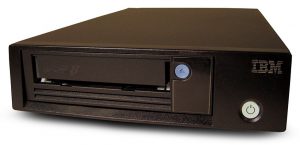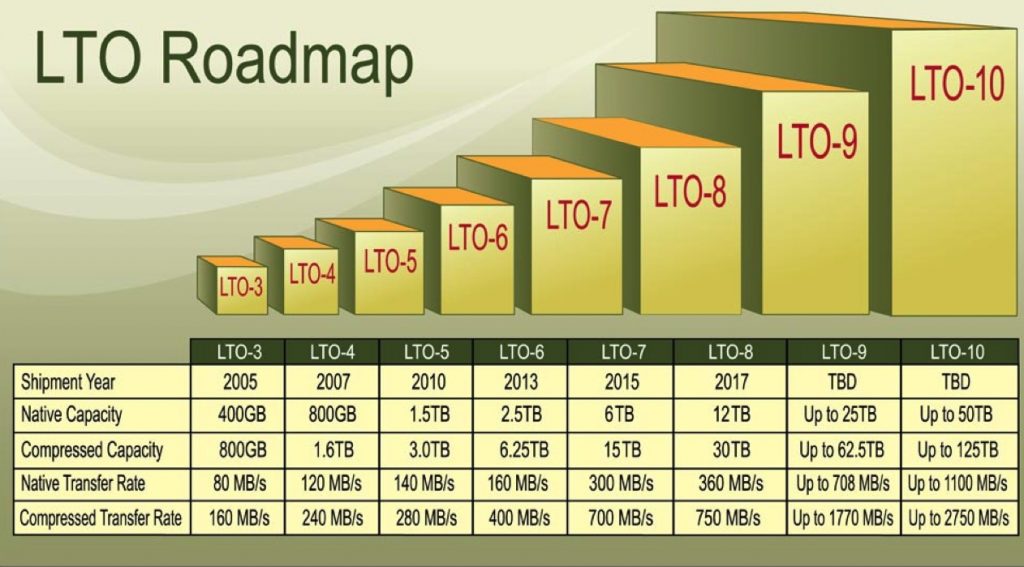LTO-8 Soon Available From IBM
Native 12TB and 360MB/s, 2.5X more with compression
This is a Press Release edited by StorageNewsletter.com on October 16, 2017 at 2:33 pmTo improve security measures and safeguard critical information, enterprises spanning a variety of industries have long relied upon technology whose origins go back more than 65 years.
The reasons why tape storage remains part of today’s overall data management plan are:
• Cost
• The ability to keep pace with performance
• Tape’s security capabilities
Being a physical media that can be kept under lock and key provides one layer of security. However, beyond locking away cartridges when not in use, encryption and WORM functionalities are providing users with deeper levels of data protection. Not satisfied with relying solely on security, tape engineers have also kept pace with performance.
According to the Tape Storage Council’s State of the Tape Industry Report, tape data rates are expected to be as much as five times faster than HDD drives by 2025. This is great news for users whose archives include data from the IoT and big data analytics, as well as content from mobile and social systems, video streaming hybrid cloud workloads and traditional data center applications.
Introducing LTO-8
IBM is announcing its Linear Tape Open Ultrium 8 Tape drive (LTO-8), which doubles the capacity from its previous generation, shortens data access times by 20% and drives down costs below the half-cent per gigabyte barrier.
Christian Otte, server center manager, VEKA AG, manufacturer of windows and doors, says: “IBM’s continued investment to increase performance that can help improve our ability to meet our security and regulatory requirements in tape technologies is important to our business. IBM’s ongoing commitment to tape is providing more value than ever.”
Available in 4Q17, LTO-8 joins a range of tape storage solutions providing clients with an economical choice in data preservation with increased functionalities. It maintains continued support for AME and AES-256 standard encryption, data partitioning and security key management while maintaining compatibility with LTO-7.
IBM Tape Storage – 65 years and counting
65 years ago our first marketed tape drive, the IBM 726, replaced a long-held and profitable punch card business. While a lifetime has passed since that time, it has not changed IBM’s commitment to tape media as is evidenced by the recent tape milestone achieved by IBM and Sony. It demonstrated an ability to store up to 330TB of uncompressed data on a single tape cartridge the size of your hand.
Jon Toigo, chairman, Data Management Institute, and managing principal partner, Toigo Partners International LLC says: “The tape industry is consolidating around one drive maker and only a couple of media makers. That would signal alarm were it not for the capabilities and value that tape technology vendors, including IBM, are bringing to the storage medium. With the latest IBM announcements, the future for LTO tape technology has never looked brighter.“
Comments
Two years after announcing LTO-7 and five years after launching LTO-6, IBM reveals the first LTO-8 tape drives as well as a lot of libraries integrating the new format (see other news today).
The main specs: capacity per cartridge of native 12TB (and 30TB with 2.5 to 1 compression) - twice more than LTO-7 -, data transfer does not follow the same pace with native up to 360MB/s for FH tape drives and 300MB/s for HH devices to be compared to 300MB/s for LTO-7.
At a time, native specs of LTO-8 were supposed to be 12.8TB and 472MB/s on the LTO Consortium' roadmap.
The LTO-8 uses LTO-DC, which is an implementation of a Lempel-Ziv class 1 (LZ-1) data compression algorithm. It is an extension of Adaptive Lossless Data Compression (ALDC) and an improvement over previous IBM lossless compression algorithms. Scheme-Swapping compression, patented by IBM, is designed to look ahead at incoming data and determine the most efficient storage method (either ALDC or pass-thru mode) to help provide optimal data compression and increase data throughput.
IBM TS2280 LTO-8 Tape Drive

To double the capacity, the drives uses a dual-stage 32-channel head actuator (data are written 32 at a time) designed to provide precision head alignment to help support higher track density and improved data integrity. Track following skew actuator supports flangeless tape guide rollers and dynamic skew to enable the head to follow skew tape motion and improve linear actuation. The unit also utilizes improved tunneling magnetoresistive (TMR) drive heads, as opposed to GMR heads used in previous generations. There are 6,656 data tracks in LTO-8. The high-bandwidth servo system features a low-mass servo to help more effectively track servo bands and improve data throughput with damaged media in less-than-optimal shock and vibration environments.
The IBM LTO-8 tape drive also uses Statistical Analysis and Reporting System (SARS) to help isolate failures between media and hardware. SARS uses the cartridge performance history saved in the cartridge memory module and the drive performance history kept in the drive flash to help.
IBM LTO-8 tape drives can also read and write LTO-7 (maybe read LTO-6) and are offered with 8Gb FC or 6Gb SAS interfaces.
Availability will be between this month and December depending on the configurations. Library maker Spectra Logic said it expects to ship LTO-8 tape technology in the Fall of 2017.
LTO roadmap

Nathan Thompson, Spectra Logic CEO, foresees the availability of LTO-9 at 24TB per tape cartridge in two years, LTO-10 at 48TB in four years, LTO-11 at 96TB in six or seven years, and LTO-12 at 190+TB in eight to nine years.
LTO technology was developed jointly by Certance (now Quantum), Hewlett Packard Enterprise, and especially IBM in 1998. The three companies set out to develop an "open format" technology so that users would have multiple sources of product and media.
But the reality is now different as now we have just one drive maker (IBM) - as HPE, that was in LTO-7 has not yet revealed its entrance into LTO-8. According to Roger Mahon, CEO, mLogic, using LTO-8 drives for subsystems," the only manufacturer of LTO-8 drives is IBM. All other vendors( HP, Quantum, Tandberg, etc.) OEM from IBM. Fujifilm and Sony will be making LTO8 media. It is my understanding that Sony will be first to market."
And there are less and less media manufacturers, just two and no more Imation, Maxell or TDK. Both FujiFilm and Sony are IBM's partners for cartridge technology. Last August Sony announced a collaboration with IBM Research for a magnetic tape technology with the industry's highest recording areal density for tape storage media, at 201 gigabits per square inch able to pack 330TB in just one cartridge.
Compatibility seems to be a problem if another company enters into drive manufacturing : "The LTO generation 8 media specification up to 30TB compressed data cartridges can only be used on the new IBM LTO Ultrium 8 tape drives," stated Big Blue.
With 12TB native, LTO-8 is now approching the highest capacity of helium-based HDDs, also at 12TB.
Read also:
IBM First to Reveal LTO-7 Product
Half-height drive to be available in November 20
By Jean Jacques Maleval on 2015.10.07













 Subscribe to our free daily newsletter
Subscribe to our free daily newsletter

